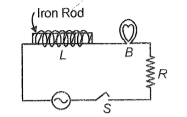Current through an elements in ac circuit is said to be wattless, when the elements is
1. Pure inductor (L)
2. Pure capacitor (C)
3. Series L-C circuit
4. All of these
An LC circuit contains an inductor (L=25 mH) and a capacitor (C=25 mF) with an initial charge of Q0. At what time will the circuit have an equal amount of electrical and magnetic energy?
4. All of these
In which of the following circuits can the power factor be zero?
1. LC circuit
2. LCR circuit
3. Purely resistive circuit
4. Both (1) & (2)
The quality factor of the resonance circuit is given by (symbols have usual meanings)
In the given circuit, switch S is closed at t=0. After a long time, the iron rod is withdrawn from the inductor L. Then, the bulb

1. Glow with the same brightness
2. Glows more brightly
3. Gets dimmer
4. Stops glowing
The circuit is in a steady state when the key is at position \(1\). If the switch is changed from position \(1\) to position \(2\), then the steady current in the circuit will be:
| 1. | \(E_o \over R\) | 2. | \(E_o \over 3R\) |
| 3. | \(E_o \over 2R\) | 4. | \(E_o \over 4R\) |
LCR series circuit is connected with an alternating emf source. If the peak current and voltage are respectively then at resonance the value of wattless current is
The value of quality factor ( Q-value) of the series resonant circuit with inductance L = 2.0 H, capacitance C= 32 and resistance R = 10 , is
1. 25
2. 250
3. 0.25
4. 2.5
| Assertion (A): | When a current \(I=(3+4 \sin \omega t)\) flows in a wire, then the reading of a dc ammeter connected in series is \(4\) units. |
| Reason (R): | A dc ammeter measures only the value of the current amplitude. |
| 1. | Both (A) and (R) are True and (R) is the correct explanation of (A). |
| 2. | Both (A) and (R) are True but (R) is not the correct explanation of (A). |
| 3. | (A) is True but (R) is False. |
| 4. | Both (A) and (R) are False. |
| Assertion (A): | A capacitor can replace the choke coils in an AC circuit. |
| Reason (R): | A capacitor can reduce the current in an AC circuit like an inductor |
In the light of the above statements choose the correct answer from the options given below:
| 1. | Both (A) and (R) are true and (R) is the correct explanation of (A). |
| 2. | Both (A) and (R) are true but (R) is not the correct explanation of (A). |
| 3. | (A) is true but (R) is false. |
| 4. | Both (A) and (R) are false. |







